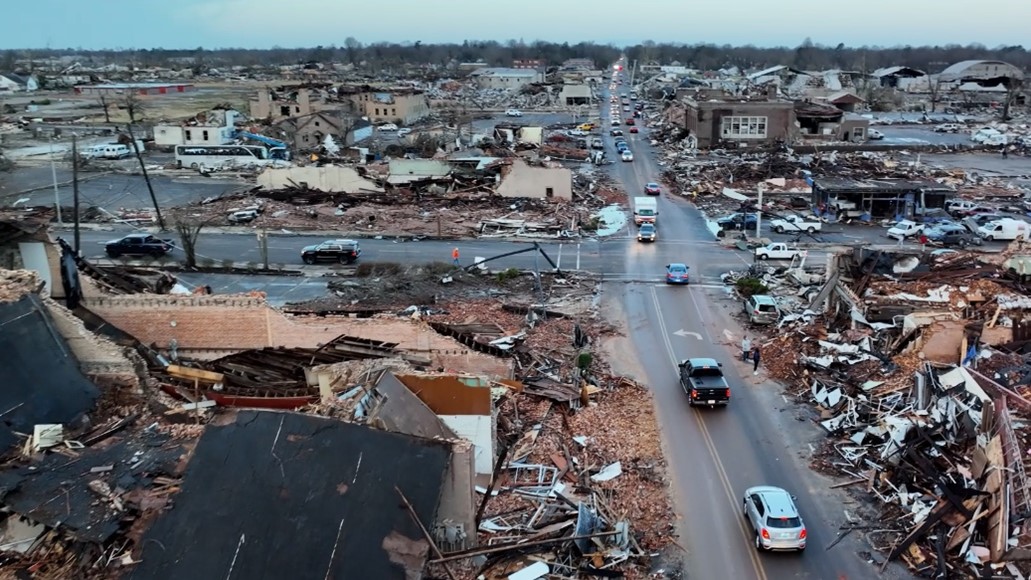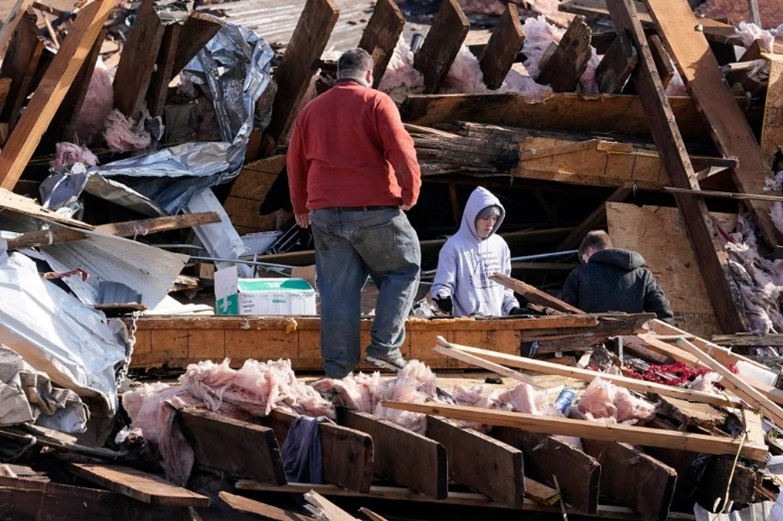
Featured Photo by NPR
The tornado that tore through Mayfield, Kentucky caused untold devastation. Entire neighborhoods were blown apart by the extreme winds, and weeks later, survivors are still feeling traumatized. Marty Janes and his wife were getting ready for bed when the storm ripped off their roof. “It sounded like a nuclear bomb,” he said. The two were on opposite ends of the house, and Marty was badly cut as he tried to reach his wife, who was trapped under the wreckage. Paramedics finally rescued Marty and took him to the hospital, and it was twenty-four long hours before he knew for sure that his wife had survived.
The storm took seventy-seven lives in Kentucky, plus another dozen in surrounding states. When you meet people who went through this storm you hear stories of miracles, answered prayers, heartbreaking losses and questions on why this happened. Many are now living with relatives like Jada and Jerritt Watts and their infant daughter who were looking forward to celebrating their first Christmas in a house they had bought this past year. When they heard tornado sirens, they took shelter in the bathtub and covered their heads with a pillow. Their house exploded and the tub was catapulted into the street. Miraculously, all survived.
Unfortunately, like the Watts family, most Americans are uninformed on benefits of various construction materials that could provide a safer living environment.

Too many times, we have heard stories from friends, families and news outlets about people losing everything. As I write this article, I wonder what can be done?
Keep in mind, at the most fundamental level, building codes were established to protect the health, safety, and welfare of communities. Is building to minimum standards a benefit or disaster waiting to happen across this great nation? Are we more concerned about profit margins instead of the health, safety and welfare of American citizens? Some will say that it is a complicated answer but let’s be honest, money drives most decisions and not the loss of property and lives.
One of the best ways that citizens can fight for their communities is to push for stronger building codes. Citizens should demand structures to be built above the minimum building standards. The lack of information to families and communities around the nation is a large concern of the Southeast Concrete Masonry Association (SCMA). The SCMA has a responsibility to be a resource on how to build more resilient and sustainable communities and allow concrete masonry to be part of the overall solution.
As we move into 2022, we have shifted our Concrete Masonry Academy focus to quarterly initiatives to help the professional community and consumers become educated on why concrete masonry is the best solution to help communities create a safer place to call home.
Disaster Resistance Properties of Concrete Masonry
FIRE RESISTANCE
Concrete masonry offers a noncombustible option for construction – providing protection for occupants and property.
- For interior walls, it helps contain a fire
within the compartment, preventing it from spreading throughout the
building. - As an exterior wall, it helps prevent a fire
from jumping from building to building. - Concrete masonry helps contain a fire even if
no water supply is available. - Concrete masonry structures that endure a fire
can often be rebuilt with little envelope reconstruction.
WIND RESISTANCE
Debris driven by high winds presents the greatest hazard during hurricanes and tornados. Tests show that concrete masonry wall systems suffer no structural damage when impacted by debris carried by hurricane and tornado-force winds.
FLOOD RESISTANCE
Concrete masonry is not damaged by water. In fact, it continues to gain strength in the presence of moisture. In flood-damaged areas, masonry buildings are often the only ones left standing, and are ready for reuse.
EARTHQUAKE RESISTANCE
Buildings constructed according to proper guidelines with reinforced masonry walls have a record of surviving earthquakes intact and structurally sound. In reinforced masonry construction, the combination of concrete and steel provides the three most important properties for earthquake resistance: stiffness, strength and ductility.
BLAST RESISTANCE
Due to the sheer mass of concrete masonry, it has demonstrated superior blast resistance through years of critical tests. It is specified on many governmental and other security-related structures.
Click here to learn more about why concrete masonry is safe and resilient.
Please stand up for your community and demand stronger building codes. Your family deserves a safer community and tomorrow!
